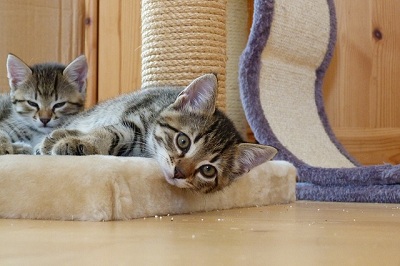How to Stop a Cat from Scratching Furniture?
How to Stop a Cat from Scratching Furniture?
Cats are amazing pets that teach us how to be more relaxed, easy-going and self-contained. However, to have a cat often includes having ragged furniture because of feline’s habit – scratching. Some owners peacefully accept things as they are, allowing a cat to scratch furniture. On the other hand, a majority of cat parents is not thrilled by cat’s scratching habit, trying different methods to make them stop scratching furniture. Feline experts believe that this behavior represents cat natural way of being in the world. It is a part of being a cat. They think that we do a completely wrong thing when banning a cat to claw at the furniture. According to them, repression will not bring good results, because scratching is part of their nature. If we want to teach them an appropriate behavior, we need to provide scratching posts first. Cats need an alternative solution for furniture. Scratching posts should be the right size, stable, of the right material and placed at the right location. If we live in a multi-cat household, we will need scratching posts for all cats. The best scratching post is the one that is a little over the size of the cat, covered with sisal. This material helps felines to sharpen their claws without being hurt. Scratching posts should be placed where a cat spends the most of her time. However, some people come to an idea to declaw a cat. Many cat owners and animal lovers are strictly against it because declawing harms a cat on many levels. To learn more against declawing, the article “Cat Scratching: Explanations and Solutions” explains why declawing is not a good idea to stop a cat from scratching.
How to Stop a Cat from Scratching Furniture?
Declawing is literally maiming a cat, a mistake that can lead to physical, emotional, and behavioral complications. It is erroneous to think that declawing a cat is a trivial procedure similar to trimming fingernails. A cat’s claws are a vital part of her anatomy, essential to balance, mobility, and survival.
Declawing is an irreversible surgical procedure that involves amputating a cat’s toes up to the first joint. It is a very painful surgery with a strong potential for secondary complications. Imagine having the last joint of your own fingers amputated: not a pleasant thought
On rare occasions, declawing may lead to secondary contracture of the tendons. This makes it uncomfortable for the cat to walk. Since the last joints of her front paws are missing, she compensates by placing more of her weight on her hindquarters, causing her to be out of balance. This shift of weight to the back feet may lead to atrophy of the muscles of her front limbs and strain injuries to the back ones.
Additionally, when we find the right scratching post, will need extra time to teach a cat to use it. Maybe we will need to sprinkle catnip or play with an exciting toy to encourage a cat to use a scratching post instead to claw at the furniture. Placing it near the cat’s favorite sofa will gradually stop a cat from scratching furniture.










